Douglas A-4 Skyhawk
| A-4 (A4D) Skyhawk | |
|---|---|
|
|
|
| A U.S. Navy A-4E of VA-164 from USS Oriskany (CVA-34) over North Vietnam in November 1967 | |
| Role | Ground-attack aircraft |
| National origin | United States |
| Manufacturer | Douglas Aircraft Company McDonnell Douglas |
| Designed by | Ed Heinemann |
| First flight | 22 June 1954 |
| Introduced | October 1956 |
| Retired | 2003, USN 1998, USMC |
| Status | Active with non-U.S. users |
| Primary users | United States Navy United States Marine Corps |
| Number built | 2,960 |
| Unit cost | US$860,000 each for the first 500 units |
| Variants | A-4AR Fightinghawk A-4SU Super Skyhawk |
The Douglas A-4 Skyhawk is a carrier-capable ground-attack aircraft designed for the United States Navy and U.S. Marine Corps. The delta winged, single turbojet-engined Skyhawk was designed and produced by Douglas Aircraft Company, and later McDonnell Douglas. It was originally designated the A4D under the US Navy's pre-1962 designation system.
Fifty years after the aircraft's first flight, and having played key roles in the Vietnam War, the Yom Kippur War, and the Falklands War, some of the nearly 3,000 Skyhawks produced remain in service with several air arms around the world, including active duty on the aircraft carrier, São Paulo, of the Brazilian Navy.
Contents |
Design and development
The Skyhawk was designed by Douglas Aircraft's Ed Heinemann in response to a U.S. Navy call for a jet-powered attack aircraft to replace the older AD Skyraider.[1] Heinemann opted for a design that would minimize its size, weight, and complexity. The result was an aircraft that weighed only half of the Navy's weight specification. It had a wing so compact that it did not need to be folded for carrier stowage. The diminutive Skyhawk soon received the nicknames "Scooter", "Kiddiecar", "Bantam Bomber", "Tinker Toy Bomber", and, on account of its nimble performance, "Heinemann's Hot-Rod".[2]

The aircraft is of conventional post-World War II design, with a low-mounted delta wing, tricycle undercarriage, and a single turbojet engine in the rear fuselage, with two air intakes on the fuselage sides. The tail is of cruciform design, with the horizontal stabilizer mounted above the fuselage. Armament consisted of two 20 mm (.79 in caliber) Colt Mk 12 cannons, one in each wing root, with 200 rpg, plus a large variety of bombs, rockets, and missiles carried on a hardpoint under the fuselage centerline and hardpoints under each wing (originally one per wing, later two).
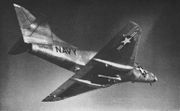
The choice of a delta wing, for example, combined speed and maneuverability with a large fuel capacity and small overall size, thus not requiring folding wings, albeit at the expense of cruising efficiency. The leading edge slats were designed to drop automatically at the appropriate speed by gravity and air pressure, saving weight and space by omitting actuation motors and switches. Similarly the main undercarriage did not penetrate the main wing spar, designed so that when retracted only the wheel itself was inside the wing and the undercarriage struts were housed in a fairing below the wing. The wing structure itself could be lighter with the same overall strength and the absence of a wing folding mechanism further reduced weight. This is the opposite of what can often happen in aircraft design where a small weight increase in one area leads to a compounding increase in weight in other areas to compensate, leading to the need for more powerful, heavier engines and so on in a vicious circle.[3][4][5]
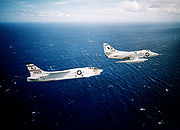
The A-4 pioneered the concept of "buddy" air-to-air refueling. This allows the aircraft to supply others of the same type, eliminating the need of dedicated tanker aircraft—a particular advantage for small air arms or when operating in remote locations. This allows for greatly improved operational flexibility and reassurance against the loss or malfunction of tanker aircraft, though this procedure reduces the effective combat force on board the carrier. A designated supply A-4 would mount a center-mounted "buddy store", a large external fuel tank with a hose reel in the aft section and an extensible drogue refueling bucket. This aircraft was fueled up without armament and launched first. Attack aircraft would be armed to the maximum and given as much fuel as was allowable by maximum takeoff weight limits, far less than a full tank. Once airborne, they would then proceed to top off their fuel tanks from the tanker using the A-4's fixed refueling probe on the starboard side of the aircraft nose. They could then sortie with both full armament and fuel loads. While rarely used in U.S. service since the KA-3 Skywarrior tanker became available, the F/A-18E/F Super Hornet includes this capability.

The A-4 was also designed to be able to make an emergency landing, in the event of a hydraulic failure, on the two drop tanks nearly always carried by these aircraft. Such landings resulted in only minor damage to the nose of the aircraft which could be repaired in less than an hour. Ed Heinemann is credited with having a large "K.I.S.S." sign put up on the wall of the drawing office when the aircraft was being designed. Whether or not this is true, the A-4 certainly is a shining example of the application of that principle to aircraft design.
The Navy issued a contract for the type on 12 June 1952,[6] and the first prototype first flew from Edwards Air Force Base, California on 22 June 1954.[7] Deliveries to Navy and U.S. Marine Corps squadrons (to VA-72 and VMA-224 respectively) commenced in late 1956.[8]
The Skyhawk remained in production until 1979, with a total of 2,960 aircraft built, including 555 two-seat trainers.[9] The last production A-4, an A-4M issued to a Marine squadron (VMA-223) had the flags of all nations who had operated the A-4 series aircraft painted on the dorsal avonics 'hump'.
Operational history
United States
The Skyhawk proved to be a relatively common U.S. naval aircraft export of the postwar era. Due to its small size, it could be operated from the older, smaller World War II-era aircraft carriers still used by many smaller navies during the 1960s. These older ships were often unable to accommodate newer USN fighters such as the F-4 Phantom II and F-8 Crusader, which were faster and more capable than the A-4, but significantly larger and heavier than older naval fighters.
The US Navy operated the A-4 in both Regular Navy and Naval Reserve light attack squadrons (VA). Although the A-4's use as a training and adversary aircraft would continue well into the 1980s, the Navy began removing the aircraft from its front line attack squadrons in 1967, with the last one being retired in 1975.
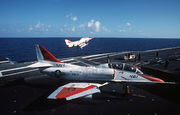
The U.S. Marine Corps would not take the U.S. Navy's replacement warplane, the A-7 Corsair II, instead keeping Skyhawks in service with both Regular Marine Corps and Marine Corps Reserve attack squadrons (VMA), and ordering the new A-4M model. The last USMC Skyhawk was delivered in 1979, and they were used until the mid-1980s before they were replaced by the equally small, but more versatile STOVL AV-8 Harrier II.[10]
The Diamondbacks of VMA-131, Marine Aircraft Group 49, retired its last four OA-4Ms on 22 June 1994. Lieutenant Colonel George "Eagle" Lake III (CO), Major John "Baja" Rufo (XO), Captain Dave "Yoda" Hurston, and Major Mike "Struts" Volland flew a final official USMC A-4 sortie during the A-4 Standdown Ceremony. Trainer versions of the Skyhawk remained in Navy service, however, finding a new lease on life with the advent of "adversary training", where the nimble A-4 was used as a stand-in for the Mikoyan-Gurevich MiG-17 in dissimilar air combat training (DACT). It served in that role at "Top Gun" until 1999.
The A-4's nimble performance also made it suitable to replace the F-4 Phantom II when the Navy downsized its aircraft for the Blue Angels demonstration team, until the availability of the F/A-18 Hornet in the 1980s. The last US Navy Skyhawks, TA-4J models belonging to the composite squadron VC-8, remained in military use for target-towing, and as adversary aircraft, for combat training at Naval Station Roosevelt Roads. These aircraft were officially retired on 3 May 2003.
Skyhawks were well-loved by their crews for being tough and agile. These attributes, along with their low purchase and operating cost as well as easy maintenance, have contributed to the popularity of the A-4 with American and international armed forces. Besides the United States, at least three other nations have used A-4 Skyhawks in combat (Argentina, Israel, and Kuwait).
Vietnam War era
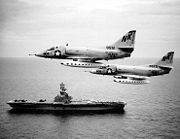
Skyhawks were the Navy's primary light bomber used over North Vietnam during the early years of the Vietnam War while the USAF was flying the supersonic F-105 Thunderchief; they were later supplanted by the A-7 Corsair II in the Navy light bomber role. Skyhawks carried out some of the first air strikes by the US during the conflict, and a Marine Skyhawk is believed to have dropped the last American bombs on the country. Notable naval aviators who flew the Skyhawk included Lieutenant Commanders Everett Alvarez Jr. and John McCain, and Commander James Stockdale. On 1 May 1967, an A-4C Skyhawk piloted by Lieutenant Commander Theodore R. Swartz of VA-76 aboard the carrier USS Bon Homme Richard, shot down a North Vietnamese Air Force MiG-17 with an unguided Zuni rocket as the Skyhawk's only air-to-air victory of the Vietnam war.[11][12]
From 1956 on, Navy Skyhawks were the first aircraft to be deployed outside of the U.S. armed with the AIM-9 Sidewinder.[13][14] On strike missions, which was the Skyhawk's normal role, the air-to-air armament was for self defensive purposes.
In the early-to-mid 1960s, standard US Navy A-4B Skyhawk squadrons were assigned to provide daytime fighter protection for ASW aircraft operating from some Essex class US anti-submarine warfare carriers, these aircraft retained their ground- and sea-attack capabilities. The A-4B model did not have an air-to-air radar, and it required visual identification of targets and guidance from either ships in the fleet or an airborne E-1 Tracer AEW aircraft. Lightweight and safer to land on smaller decks, Skyhawks would later also play a similar role flying from Australian, Argentinean, and Brazilian upgraded World War II surplus light ASW carriers, which were also unable to operate most large modern fighters.[15][16][17] Primary air-to-air armament consisted of the internal 20 mm (.79 in) Colt cannons and ability to carry an AIM-9 Sidewinder missile on both underwing hardpoints, later additions of two more underwing hardpoints on some aircraft made for a total capacity of four AAMs.
The first combat loss of an A-4 occurred on 5 August 1964, when Lieutenant junior grade Alvarez, of VA-144 aboard the USS Constellation, was shot down while attacking enemy torpedo boats in North Vietnam. Alvarez safely ejected after being hit by anti-aircraft artillery (AAA) fire, and became the first US Naval POW of the war;[18] he was released as a POW on 12 February 1973. The last A-4 to be lost in the Vietnam War occurred on 26 September 1972, when USMC pilot Captain James P. Walsh, USMC of VMA-211, flying from his land base at Bien Hoa Air Base, South Vietnam, was hit by ground fire near An Loc. An Loc was one of the few remaining hotly contested areas during this time period, and Captain Walsh was providing close air support (CAS) for ground troops in contact (land battle/fire fight) when his A-4 was hit, catching fire, forcing him to eject. Rescue units were sent, but the SAR helicopter was damaged by enemy ground fire, and forced to withdraw. Captain Walsh, after safely ejecting, had landed within NVA (North Vietnamese Army) positions, and had become a POW as soon as his feet had touched the ground. Captain Walsh was the last US Marine to be taken prisoner during the war, and was released as a POW on 12 February 1973.
On 29 July 1967, the aircraft carrier USS Forrestal was conducting combat operations in the Gulf of Tonkin during the Vietnam War. A Zuni rocket misfired, knocking off an external tank on an A-4. Fuel from the leaking tank caught fire, creating a massive conflagration that burned for hours, killing 134 sailors, and injuring 161. (See 1967 USS Forrestal fire.)
During the war, 362 A-4/TA-4F Skyhawks were lost to all causes. The US Navy lost 271 A-4s, the US Marine Corps lost 81 A-4s and 10 TA-4Fs. A total of 32 A-4s were lost to surface-to-air missiles (SAMs), and one A-4 was lost in aerial combat to a MiG-17 on 25 April 1967.[19]
Training/Adversary role
The A-4 Skyhawk was introduced to a training role in the two-seat TA-4J configuration replacing the TF-9J Cougar as the advanced jet trainer The TA-4J served as the advanced jet trainer in white and orange markings for decades until being replaced by the T-45 Goshawk. Additional TA-4J Skyhawks were assigned to Instrument Training RAGs at all the Navy "master jet bases" under RCVW-12 and RCVW-4. The Instrument RAGs initially provided jet transition training for Naval Aviators during the time period when Naval Aviation still had a great number of propeller-driven aircraft and also provided annual instrument training and check rides for Naval Aviators. The assigned TA-4J models were installed with collapsible hoods so the aviator under training had to demonstrate instrument flying skills without any outside reference. These units were VF-126 at NAS Miramar, VA-127 (later VFA-127) at NAS Lemoore, VF-43 at NAS Oceana and VA-45 (later VF-45) at NAS Cecil Field until its later move to NAS Key West.
Additional single-seat A-4 Skyhawks were also assigned to composite squadrons (VC) worldwide to provide training and other services to deployed units. These included VC-1 at NAS Barber's Point, VC-7 at NAS Miramar, VC-5 at NAS Cubi Point, the Philippines, VC-8 at NS Roosevelt Roads, Puerto Rico, VC-10 at NAVBASE Guantánamo Bay, Cuba, and Naval Reserve squadrons VC-12 (later VFC-12) at NAS Oceana and VC-13 (later VFC-13) at NAS Miramar.
With renewed emphasis on Air Combat Maneuvering (ACM) training brought on with the establishment of the Navy Fighter Weapons School (TOPGUN) in 1968, the availability of A-4 Skyhawks in both the Instrument RAGs and Composite Squadrons at the "master jet bases" presented a ready resource of the nimble Skyhawks that had become the TOPGUN preferred surrogate for the MiG-17. At the time, the F-4 Phantom was just beginning to be exploited to its full potential as a fighter and had not performed as well as expected against the smaller North Vietnamese MiG-17 and MiG-21 opponents. TOPGUN introduced the notion of dissimilar air combat training (DACT) using the A-4E in the stripped "Mongoose" configuration with fixed slats.
The small size of the Skyhawk and superb low speed handling in the hands of a well trained aviator made it ideal to teach fleet aviators the finer points of DACT. The squadrons eventually began to display vivid threat type paint schemes signifying their transition into the primary role of Adversary training. To better perform the Adversary role, single-seat A-4E and F models were introduced into the role, but the ultimate adversary Skyhawk was the "Super Fox," which was equipped with the uprated J52-P-408 engine similar to the configuration used by the Blue Angels.
The surplus of former USMC Skyhawks resulted in A-4M versions being used by both VF-126 and TOPGUN. Even though the A-4 was augmented by the F-5E, F-21 (Kfir), F-16, and F/A-18 in the Adversary role, the A-4 remained a viable threat surrogate until it was retired by VF-43 in 1993 and shortly thereafter by VFC-12. The last A-4 fleet operators were VC-8, which retired its Skyhawks in 2003.
The A-4M was also operated by the Operations Maintenance Detachment(OMD) in an Adversary role based at Naval Air Station Dallas for the Naval Air Reserve. Many of the aviators that flew the 4 jets were attached to NAS Dallas, including the Commanding Officer. The aircraft were instrumental in training and development of Air Combat Maneuvers(ACM) for VF-201 and VF-202. The unit also completed several missions involving target towing to NAS Key West, NAS Kingsville, TX, and deployments to NAS Miramar, CA and NAS Fallon, NV for adversary support. The detachment was under the operational command of the Commander Fleet Logistics Support Wing(CFLSW) based at NAS Dallas.
Israel
In the late 1960s and 1970s, Israeli Air Force Skyhawks were the primary ground attack aircraft in the War of Attrition and the Yom Kippur War. They cost only ¼ what a Phantom II cost and carried more bombs and had longer range than the air superiority fighters they replaced.[20] In May 1970, an Israeli Skyhawk piloted by Col. Ezra Dotan shot down two MiG-17s, one with unguided rockets, the other with 30 millimetres (1.2 in) canon fire over south Lebanon, even though the Skyhawk's heads up display has no "air to air mode". The Skyhawks bore the brunt of losses to sophisticated SA-6 Gainful missile batteries.
During the 1982 Lebanon War an Israeli A-4 piloted by Aharon Ahiaz was shot down over Lebanon on 6 June 1982.[21][22][23] Israel claimed this was one of its only two fixed wing aircraft shot down over the Bekka Valley during the air battle from 6 June 1982 to 11 June 1982 where 150 aircraft took part.[24] The Skyhawks have been replaced by F-16s but are still used for pilot training. In October 2008, it was decided due to maintenance issues that the A-4 fleet would be grounded and replaced.[25]
Argentina
Argentina was not only the first foreign user of the Skyhawk but also one of the largest with nearly 130 A-4s delivered since 1965. The Argentine Air Force received 25 A-4Bs in 1966 and another 25 in 1970, all refurbished in the United States by Lockheed Service Co. prior to their delivery as A-4P, although they were still locally known as A-4B. They had three weapon pylons and served in the 5th Air Brigade (Spanish: V Brigada Aérea). In 1976, another order was made for 25 A-4Cs to replace the F-86 Sabres still in service in the 4th Air Brigade (Spanish: IV Brigada Aérea). They were received as is and refurbished to flight status by the Air Force technicians at Río Cuarto, Cordoba. The C model had five weapon pylons and could use AAM AIM-9B Sidewinders.
The Argentine Naval Aviation also bought the Skyhawk known as A-4Q in the form of 16 A-4B plus two for spare parts, modified with five weapon pylons and to carry AIM-9B Sidewinders. They were received in 1971 to replace F9F Panther and F9F Cougar in use from the aircraft carrier ARA Veinticinco de Mayo by the 3rd Fighter/Attack Squadron (Spanish: 3ra Escuadrilla Aeronaval de Caza y Ataque).
The United States placed an embargo of spare parts in 1977 due to the Dirty War[26] backing the Humphrey-Kennedy amendment to the Foreign Assistance Act of 1976, the Carter administration placed an embargo on the sale of arms and spare parts to Argentina and on the training of its military personnel (which was lifted in the 1990s under Carlos Menem's presidency when Argentina became a Major non-NATO ally).[27] Ejection seats did not work and there were many other mechanical faults.[28] In spite of this, A-4s still served well in the 1982 Falklands War where they achieved some success against the Royal Navy.
Falklands War

During the 1982 Falklands War, armed with unguided bombs and lacking any electronic or missile self-defense, Argentine Air Force Skyhawks sank the Type 42 Destroyer HMS Coventry and the Type 21 Frigate HMS Antelope as well as inflicting heavy damage on several others: the RFA Sir Galahad (1966) (which was subsequently scuttled as a war grave), the Type 42 HMS Glasgow, the Leander Class Frigate HMS Argonaut, the Type 22 Frigate HMS Broadsword, and the RFA Sir Tristram. Argentine Navy A-4Qs, flying from Río Grande, Tierra del Fuego naval air station, also played a role in the bombing attacks against British ships, destroying the Type 21 HMS Ardent.[29]
In all, 22 Skyhawks (10 A-4Ps, nine A-4Cs, and three A-4Qs) were lost to all causes in the six weeks-long war.[30]
After the war, Argentine Air Force A-4Ps and A-4Cs survivors were upgraded under the Halcon program with 30 mm (1.18 in) guns, air-to-air missiles, and other minor details, and merged into the 5th Air Brigade. All of these were withdrawn from service in 1999, and they were replaced with 36 of the much improved OA/A-4AR Fightinghawk. Several TA-4J and A-4E airframes were also delivered under the A-4AR program mainly for spare parts use.
In 1983, the United States vetoed the delivery by Israel of 24 A-4H Skyhawks for the Argentine Navy as the A-4Q replacement. The A-4Qs were finally retired in 1988.[31]
Kuwait

More recently, Kuwaiti Air Force Skyhawks fought in 1991 during Operation Desert Storm. When Iraq invaded Kuwait, the available Skyhawks flew attack missions against the advancing Iraqi forces from deserted roads after their bases were overrun. A total of 24 of the 29 A-4KUs that remained in service with Kuwait (from 36 delivered in the 1970s) escaped to Saudi Arabia. The escaped Skyhawks (along with escaped Mirage F1s) operated as the Free Kuwait Air Force, flying 1,361 sorties during the liberation of Kuwait.[32] Twenty-three A-4s survived the conflict and the Iraqi invasion,[33] with only one being destroyed in combat. The remaining Kuwaiti Skyhawks were later sold to Brazil, where they currently serve aboard the aircraft carrier NAe São Paulo.[34]
Variants


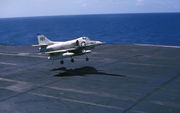


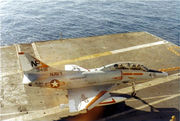

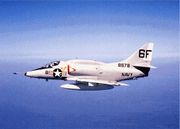
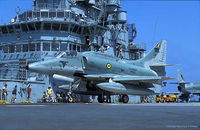
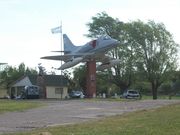

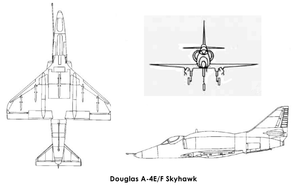
- Prototypes
- XA4D-1: Prototype
- YA4D-1 (YA-4A, later A-4A): Flight test prototypes and pre-production aircraft.
- A-4A
- A4D-1 (A-4A): Initial production version, 166 built
- A-4B
- A4D-2 (A-4B): Strengthened aircraft and added air-to-air refueling capabilities, improved navigation and flight control systems, provision for AGM-12 Bullpup missile, 542 built.
- A-4P: Remanufactured A-4Bs sold to Argentine Air Force known as A-4B by the Argentines.
- A-4Q: Remanufactured A-4Bs sold to Argentine Navy.
- A-4S: 50 A-4Bs remanufactured for Republic of Singapore Air Force.
- TA-4S: seven trainer versions of the above. Different from most TA-4 trainers with a common cockpit for the student and instructor pilot, these were essentially rebuilt with a 28 in (710 mm) fuselage plug inserted into the front fuselage and a separate bulged cockpit (giving better all round visibility) for the instructor seated behind the student pilot.
- TA-4S-1: eight trainer versions of the above. These were designated as TA-4S-1 to set it apart from the earlier batch of seven airframes.
- A4D-3: Proposed advanced avionics version, none built.
- A-4C
- A4D-2N (A-4C): Night/adverse weather version of A4D-2, with AN/APG-53A radar, autopilot, LABS low-altitude bombing system. Wright J65-W-20 engine with 8,200 lbf (36.5 kN) of takeoff thrust, 638 built.
- A-4L: 100 A-4Cs remanufactured for Marine Corps Reserves and Navy Reserve squadrons. Fitted with A-4F avionics (including the fuselage "hump") but retaining J-65 engine and three-pylon wing.[35]
- A-4S-1: 50 A-4Cs remanufactured for Republic of Singapore Air Force.
- A-4SU Super Skyhawk: extensively modified and updated version of the A-4S, exclusively for the Republic of Singapore Air Force (RSAF), fitted with a General Electric F404 non-afterburning turbofan engine, and modernized electronics.
- TA-4SU Super Skyhawk: extensively modified and updated version of the TA-4S & TA-4S-1 to TA-4SU standard.
- A-4PTM: 40 A-4Cs and A-4Ls refurbished for Royal Malaysian Air Force, incorporating many A-4M features (PTM stands for Peculiar to Malaysia).[36]
- TA-4PTM: Small number of trainer versions of above (PTM stands for Peculiar to Malaysia).[36]
- A4D-4: Long-range version with new wings cancelled; A-4D designation skipped to prevent confusion with A4D
- A-4E
- A4D-5 (A-4E): Major upgrade, including new Pratt & Whitney J52-P-6A engine with 8,400 lbf (37 kN) of thrust, strengthened airframe with two more weapon pylons (for a total of five), improved avionics, with TACAN, Doppler navigation radar, radar altimeter, toss-bombing computer, and AJB-3A low-altitude bombing system. Many later upgraded with J52-P-8 engine with 9,300 lbf (41 kN) thrust; 499 built.
- TA-4E: two A-4Es modified as prototypes of a trainer version.
- A4D-6: Proposed version, none built.
- A-4F
- A-4F: Refinement of A-4E with extra avionics housed in a hump on the fuselage spine (this feature later retrofitted to A-4Es and some A-4Cs) and more powerful J52-P-8A engine with 9,300 lbf (41 kN) of thrust, later upgraded in service to J52-P-408 with 11,200 lbf (50 kN), 147 built. Some served with Blue Angels acrobatic team from 1973 to 1986.
- TA-4F: Conversion trainer - standard A-4F with extra seat for an instructor, 241 built.
- OA-4M: 23 TA-4Fs modified for Forward Air Control duties for the USMC.
- EA-4F: four TA-4Fs converted for ECM training.
- TA-4J: Dedicated trainer version based on A-4F, but lacking weapons systems, and with down-rated engine, 277 built new, and most TA-4Fs were later converted to this configuration.
- A-4G: eight aircraft built new for the Royal Australian Navy with minor variations from the A-4F; in particular, they were not fitted with the avionics "hump". Subsequently, eight more A-4Fs were modified to this standard for the RAN. Significantly the A-4G were modified to carry four underwing Sidewinder AIM-9B missiles increasing their Fleet Defense capability.[37][38]
- TA-4G: two trainer versions of the A-4G built new, and two more modified from TA-4Fs.
- A-4H: 90 aircraft for the Israeli Air Force based on the A-4F. Used 30 mm (1.18 in) DEFA cannon with 150 rpg in place of US 20 mm (.79 in) guns. Later, some A-4Es later locally modified to this standard. Subsequently modified with extended jetpipes as protection against heat-seeking missiles.
- TA-4H: 25 trainer versions of the above. These remain in service, and are being refurbished with new avionics and systems for service till at least 2010.
- A-4K: 10 aircraft for Royal New Zealand Air Force. In the 1990s, these were upgraded under Project KAHU with new radar and avionics, provision for AGM-65 Maverick, AIM-9 Sidewinder, and GBU-16 Paveway II laser-guided bomb. The RNZAF also rebuilt an A-4C and 10 A-4Gs to A4K standard.
- TA-4K: four trainer versions of the above. A fifth was later assembled in NZ from spare parts.
- A-4M Skyhawk II
- A-4M: Dedicated Marine version with improved avionics and more powerful J52-P-408a engine with 11,200 lbf (50 kN) thrust, enlarged cockpit, IFF system. Later fitted with Hughes AN/ASB-19 Angle Rate Bombing System (ARBS) with TV and laser spot tracker, 158 built.
- A-4N: 117 modified A-4Ms for the Israeli Air Force.
- A-4KU: 30 modified A-4Ms for the Kuwaiti Air Force. Brazil purchased 20 of these second-hand and redesignated them AF-1. Now used by the Brazilian Navy on carrier duty.
- TA-4KU: three trainer versions of the above. Brazil purchased some of these second-hand and redesignated them AF-1A.
- A-4AR Fightinghawk: 36 A-4Ms refurbished for Argentina.
- TA-4R: Refurbished two-seat training version for Argentina.
- A-4Y: Provisional designation for A-4Ms modified with the ARBS. Designation never adopted by the US Navy or Marine Corps.[39]
Operators
- Argentine Air Force[40] - as fighter and fighter trainer
- Brazilian Navy[40] - naval fighter
- Israeli Air Force[40] - used as advanced trainers
- Republic of Singapore Air Force - used for Advance Jet Training (AJT) currently based at BA 120 Cazaux airbase in France.[41]
Former operators
Aircraft on display
- Argentina
- Argentine Navy A-4Q Skyhawk - serial 0661/3-A-308 BuNo 12234, Mar del Plata
- Australia
- A-4 – Australian Museum of Flight[42] at HMAS Albatross (air station) in Nowra, New South Wales
- Japan
- USMC OA-74M - MCAS Iwakuni
- New Zealand
- Early US model converted to A4K standard – Royal New Zealand Air Force Museum in Christchurch
- United States
- Tail # 2777 Marine A-4 at Nashua NH traccon station on Norteastern Blvd. on outside display Behind a security checkpoint. unknown condition.
- US Navy BuNo 158716 - Combat Air Museum, Topeka, Kansas
- US Navy A-4B Skyhawk - San Diego Air & Space Museum, San Diego, California
- US Navy A-4E Skyhawk BuNo 49996 - Evergreen Aviation Museum, McMinnville, Oregon
- US Navy A-4F Skyhawk BuNo 155036- Accomac County Airport, Accomac, Virginia
- US Navy A-4L Skyhawk BuNo 149532 - Castle Air Museum, Atwater, California
- US Navy A-4B Skyhawk – Intrepid Sea-Air-Space Museum, New York, New York
- Four former Blue Angel Skyhawks hung from atrium in "diamond" formation - National Museum of Naval Aviation, Pensacola, Florida.[43]
- USMC BuNo 151194 - Pacific Coast Air Museum, Santa Rosa, California
- New England Air Museum, Windsor Locks, Connecticut
- Entrance to former Naval Air Station South Weymouth off Rte18 in Mass. Former USMC Skyhawk #2940 of VMA-322.
- A-4B (upgraded from an A-4A) BuNo 142200 that was on display since 1969 at the main (north) gate of the former Alameda Naval Air Station in California, blown off its pylon Feb 2008 by storm winds, is undergoing restoration and is scheduled to be back on display in late 2010, repainted in the original VA-113 markings it wore fresh out the Douglas factory door in Apr 1957.
- An A-4C Skyhawk is on on display on the flight deck of the USS Yorktown (CV-10), at the Patriot's Point Naval and Maritime Museum in Mount Pleasant, South Carolina.
- USMC A-4M 160036 is on display at the Prairie Aviation Museum in Bloomington, Illinois.
- USMC A-4M on display at Marine Corps Air Ground Combat Center Twentynine Palms, Twentynine Palms, California.
- Carolinas Aviation Museum Douglas 1956 A4D-1 Skyhawk BuNo 142226 - US Marines 156th of 2960 built
Specifications (A-4F Skyhawk)
Data from www.globalsecurity.org
General characteristics
- Crew: 1 (2 in OA-4F, TA-4F, TA-4J)
- Length: 40 ft 3 in (12.22 m)
- Wingspan: 26 ft 6 in (8.38 m)
- Height: 15 ft (4.57 m)
- Wing area: 259 ft² (24.15 m²)
- Airfoil: NACA 0008-1.1-25 root, NACA 0005-0.825-50 tip
- Empty weight: 10,450 lb (4,750 kg)
- Loaded weight: 18,300 lb (8,318 kg)
- Max takeoff weight: 24,500 lb (11,136 kg)
- Powerplant: 1× Pratt & Whitney J52-P8A turbojet, 9,300 lbf (10,000+ USMC A-4M and OA-4M) (41 kN)
Performance
- Maximum speed: 585 kn (673 mph, 1,077 km/h)
- Range: 1,700 nmi (2,000 mi, 3,220 km)
- Service ceiling: 42,250 ft (12,880 m)
- Rate of climb: 8,440 ft/min (43 m/s)
- Wing loading: 70.7 lb/ft² (344.4 kg/m²)
- Thrust/weight: 0.51
- g-limit: -3/+8 g
Armament
- Guns: 2× 20 mm (0.79 in) Colt Mk 12 cannon, 100 rounds/gun
- Hardpoints: 4× under-wing & 1× under-fuselage pylon stations holding up to 9,900 lb (4,490 kg) of payload
- Rockets:
- 4× LAU-10 rocket pods (each with 4× 127 mm Mk 32 Zuni rockets)
- Missiles:
- Air-to-air missiles:
- Air-to-surface missiles:
- 2× AGM-12 Bullpup
- 2× AGM-45 Shrike anti-radiation missile
- 2× AGM-62 Walleye TV-guided glide bomb
- 2× AGM-65 Maverick
- Bombs:
- 6× Rockeye-II Mark 20 Cluster Bomb Unit (CBU)
- 6× Rockeye Mark 7/APAM-59 CBU
- Mark 80 series of unguided bombs (including 3 kg and 14 kg practice bombs)
- B57 nuclear bomb
- B61 nuclear bomb
- Others:
- up to 3× 300/330/370 US Gallon Sargent Fletcher drop tanks (pylon stations 2, 3, 4 are wet plumbed) for ferry flight/extended range/loitering time
Avionics
- Stewart-Warner AN/APQ-145 Mapping & Ranging radar (mounted on A-4F, also found on A-4E/N/S/SU)[44]
- APN 141 Doppler Ground Radar (refitted to C and E, standard in the F)
Notable appearances in media
See also
Related development
- Lockheed Martin A-4AR Fightinghawk
- ST Aerospace A-4SU Super Skyhawk
Comparable aircraft
- Dassault Étendard IV
- LTV A-7 Corsair II
- McDonnell Douglas AV-8 Harrier II
- Nanchang Q-5
Related lists
- List of attack aircraft
- List of military aircraft of the United States
References
- Notes
- ↑ Kilduff 1983, pp. 14–15.
- ↑ O'Rourke, G.G. "Of Hosenoses, Stoofs, and Lefthanded Spads." United States Naval Institute Proceedings, July 1968.
- ↑ "Skyhawk."Air Victory Museum. Retrieved: 31 October 2007.
- ↑ Museum of Flight Retrieved: 31 October 2007.
- ↑ "Collections - Aircraft - Skyhawk (A4D/A-4/TA-4)." National Museum of Naval Aviation. Retrieved: 31 October 2007.
- ↑ Gann Wings of Fame No. 4, p. 99.
- ↑ Elward 2000, p. 25.
- ↑ Gann Wings of Fame No. 4, p. 103.
- ↑ Gann Wings of Fame No. 4, p. 100.
- ↑ "AV-8B Harrier." Military Analysis Network, Federation of American Scientists. Retrieved: 13 September 2009.
- ↑ Grossnick and Armstrong 1997
- ↑ McCarthy 2009, p. 62.
- ↑ "Events: July 14, 1956." skyhawk.org. Retrieved: 13 September 2009.
- ↑ "VA 42, p. 15." history.navy.mil. Retrieved: 13 September 2009.
- ↑ "VA-93 Blue Blazers: Events 15 October 1963." skyhawk.org. Retrieved: 30 March 2010.
- ↑ "1965 Mar 22 - 1965 Oct 7, 7th WestPac cruise." uss-bennington.org. Retrieved: 13 September 2009.
- ↑ "Events Nov 1968." skyhawk.org. Retrieved: 13 September 2009.
- ↑ Dorr and Bishop 1996, pp. 34, 36.
- ↑ Hobson Chris. Vietnam Air Losses, USAF/USN/USMC, Fixed-Wing Aircraft Losses in Southeast Asia, 1961-1973. North Branch, Minnesota: Specialty Press, 2001. ISBN 1-85780-115-6.
- ↑ "A-4 Skyhawk in IAF service." geocities.com. Retrieved: 13 September 2009. archived 23 October 2009.
- ↑ "srael Vs. The PLO -The Invasion of Lebanon 1982 Part.2." Youtube.com. Retrieved: 31 August 2010.
- ↑ http://www.waronline.org/IDF/Articles/lebanon-losses.htm "Lebanon Losses."] waronline.org. Retrieved: 31 August 2010.
- ↑ Tetro, Nicholas B. "Press reports of the capture of Zachary Baumel, Yehuda Katz, and Zvi Feldman." skywar.ru. Retrieved: 31 August 2010.
- ↑ [1] Retrieved: 31 August 2010.
- ↑ "Israel’s Skyhawk Scandal Leads to End of an Era." defenseindustrydaily.com. Retrieved: 30 March 2010.
- ↑ "Argentina Industry." globalsecurity.org. Retrieved: 30 March 2010.
- ↑ "Overview of U.S. Policy towards South America and the President's Upcoming Trip to the Region." commdocs.house.gov. Retrieved: 14 March 2010.
- ↑ Freed, Kenneth. "Argentina pilots emerge as heroes in Falklands strife." Los Angeles Times, 27 May 1982. Retrieved: 14 March 2010.
- ↑ Smith, Gordon. "Argentine Aircraft and Successes against British Ships." Battle Atlas of the Falklands War 1982 - by Land, Sea and Air. Retrieved: 12 August 2008.
- ↑ Elward 2000, p. 158.
- ↑ Caza Bombarderos de la Aviación Naval: " Douglas A4-Q Skyhawk" Historia y Arqueologia Marítima, retrieved on 12 April 2010 (Spanish)
- ↑ Elward 2000, p. 164.
- ↑ Gann Wings of Fame No. 5, p. 142.
- ↑ Baugher, Joe. "Douglas A-4KU/TA-4KU Skyhawk for Kuwait". A-4 Skyhawk, 6 November 2001. Retrieved: 12 August 2008.
- ↑ Elward 2000, pp. 71–72.
- ↑ 36.0 36.1 "RMAF A-4PTM Skyhawks." skyhawk.org.
- ↑ McDonnell Douglas A4G Skyhawk, Royal Australian Navy.
- ↑ Elward 2000, p. 163.
- ↑ Gann Wings of Fame No. 4 1996, p. 114.
- ↑ 40.0 40.1 40.2 "Directory: World Air Forces", Flight International, 11–17 November 2008.
- ↑ Toh, Sandra. "Beyond Limits - Jet Training in France." MINDEF's CyberPioneer magazine, September 2002. Retrieved: 30 March 2010.
- ↑ "McDonnell Douglas A4G Skyhawk." Australia's Museum of Flight. Retrieved: 12 June 2010.
- ↑ "Blue Angels A-4E Skyhawk exhibit." National Museum of Naval Aviation.
- ↑ Designation-Systems.net: AN/APQ - Equipment Listing
- Bibliography
- Dorr, Robert F. and Chris Bishop. Vietnam Air War Debrief. London: Aerospace Publishing, 1996. ISBN 1-874023-78-6.
- Drendel, Lou. A-4 Skyhawk in Action. Carrollton, Texas: Squadron/Signal Publications, 1973. ISBN 0-89747-010-9.
- Elward, Brad. McDonnell Douglas A-4 Skyhawk. Ramsbury, Wiltshire, UK: Crowood Press, 2000. ISBN 1-86126-340-6.
- Gann, Harry S. "Douglas A-4 Skyhawk Variant Briefing: Part 1". Wings of Fame, Volume 4. London: Aerospace Publishing, 1996, pp. 98–117. ISBN 1-874023-71-9.
- Gann, Harry S. "Douglas A-4 Skyhawk Variant Briefing: Part 2: Export Versions". Wings of Fame, Volume 5. London: Aerospace Publishing, 1996, pp. 130–145. ISBN 1-874023-90-5.
- Grossnick, Roy A. and William J. Armstrong. United States Naval Aviation, 1910–1995. Annapolis, Maryland: Naval Historical Center, 1997. ISBN 0-16049-124-X.
- Hobson, Chris. Vietnam Air Losses, USAF/USN/USMC, Fixed-Wing Aircraft Losses in Southeast Asia, 1961-1973. North Branch, Minnesota: Specialty Press, 2001. ISBN 1-85780-1156.
- Kilduff, Peter. Douglas A-4 Skyhawk. London: Osprey Publishing, 1983. ISBN 0-85045-529-4.
- McCarthy, Donald J. Jr. MiG Killers: A Chronology of US Air Victories in Vietnam 1965-1973. 2009. ISBN 978-1-58007-136-9.
- Parsons, Dave and Derek Nelson. Bandits!: Pictorial History of American Adversarial Aircraft. St. Paul, Minnesota: Motorbooks International, 1993. ISBN 0-87938-623-1.
- Peacock, Lindsey. A-4 Skyhawk (Osprey Combat Aircraft series). London: Osprey Publications, 1987. ISBN 0-85045-817-X.
- Wilson, Stewart. Phantom, Hornet and Skyhawk in Australian Service. Canberra, Australia: Aerospace Publications, 1993. ISBN 1-87567-103-X.
External links
- Royal Australian Navy 805 Squadron Skyhawk information
- A-4 Skyhawk page on Boeing.com
- RNZAF Museum Skyhawk page
- The Skyhawk Association
- A-4 Skyhawk history serving with the Royal Australian Navy
- Serial number history of Australian A-4 Skyhawks, prefix N13
- A-4 at Combat Air Museum
- A-4 Skyhawk from reference book American Combat Planes of the 20th Century by R. Wagner
- AeroWeb.org A-4 Skyhawks on display
- restoration to flight of a TA-4J
|
|||||||||||||||||||||||||||||||||||||||||||||||||||||||||||||||||||||||||||||||||||||||||||||||||||||||||||||||
|
||||||||||||||